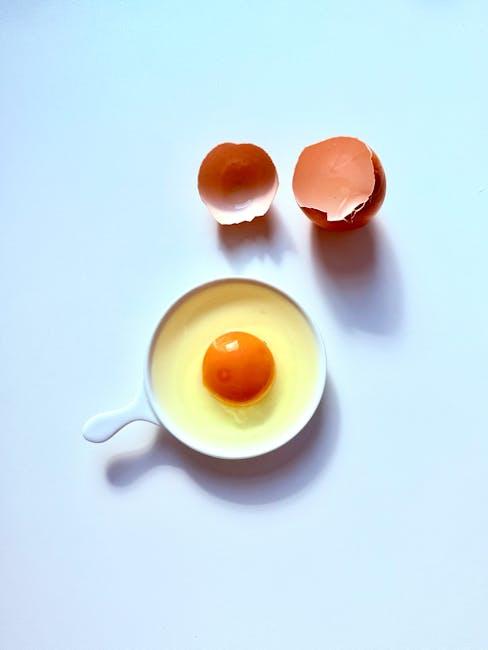In the intricate ecosystem of our bodies, the gut stands as a silent powerhouse, influencing everything from digestion to immunity and even mood. Yet, this vital organ often endures the brunt of poor diets, stress, and modern lifestyles, leading to discomfort and imbalance. Fortunately, nature offers a bounty of foods that do more than just nourish—they heal. These gut-friendly allies work quietly to restore harmony, soothe inflammation, and support a thriving microbiome. Join us as we explore the transformative power of foods that heal the gut, unveiling how the right ingredients can nurture this essential system and, in turn, enhance overall well-being.
Table of Contents
- Understanding the Gut Microbiome and Its Role in Health
- Top Nutrient-Rich Foods That Promote Gut Healing
- Fermented Foods and Their Impact on Digestive Wellness
- How Fiber Supports Gut Repair and Maintenance
- Incorporating Gut-Healing Foods Into Your Daily Routine
- Q&A
- Closing Remarks

Understanding the Gut Microbiome and Its Role in Health
The gut microbiome is a vibrant community of trillions of microorganisms living within your digestive tract. These tiny tenants play a monumental role in not only digestion but also immunity, mental health, and even metabolic processes. When this ecosystem is balanced, it aids in nutrient absorption, combats harmful bacteria, and communicates with your brain through intricate biochemical pathways. However, an imbalance, often caused by poor diet, stress, or antibiotics, can lead to inflammation, digestive issues, and a weakened immune response.
Optimizing the gut environment involves nurturing these beneficial microbes with the right foods. Incorporating prebiotic fibers feeds the good bacteria, while probiotic-rich foods introduce live beneficial strains directly into the gut. Here are some gut-friendly options to consider:
- Yogurt and Kefir: Packed with live cultures to enhance microbial diversity.
- Garlic and Onions: Natural prebiotics that fuel beneficial bacteria.
- Asparagus and Bananas: High in fibers that promote healthy bacteria growth.
- Kimchi and Sauerkraut: Fermented delights that boost probiotic presence.
| Food | Benefit | Key Nutrient |
|---|---|---|
| Yogurt | Replenishes probiotics | Live cultures |
| Garlic | Stimulates good bacteria | Fructooligosaccharides |
| Bananas | Feeds beneficial microbes | Dietary fiber |
Top Nutrient-Rich Foods That Promote Gut Healing
Incorporating certain foods into your diet can significantly enhance gut repair and support a balanced microbiome. Fermented foods like kimchi, sauerkraut, and kefir introduce beneficial probiotics that help replenish healthy gut bacteria, fostering an environment conducive to healing. Additionally, prebiotic-rich foods such as garlic, onions, and asparagus act as nourishment for these good bacteria, ensuring their survival and multiplication. Including them regularly creates a symbiotic relationship that strengthens your digestive resilience.
Moreover, foods high in collagen and glutamine contribute directly to the restoration of the gut lining, which is essential for nutrient absorption and preventing inflammation. Bone broth, rich in collagen, provides the amino acids necessary to rebuild damaged tissues, while glutamine found in foods like spinach and beets helps to maintain the integrity of the intestinal walls. Combining these nutrient powerhouses with a diverse, fiber-rich diet promotes not just gut healing but overall digestive harmony.
Fermented Foods and Their Impact on Digestive Wellness
Incorporating fermented foods into your daily diet brings a dynamic boost to digestive health by enriching your gut microbiome with beneficial bacteria. These foods undergo natural fermentation, a process that not only preserves nutrients but also creates probiotics, which are essential for maintaining the balance of gut flora. This balance helps improve digestion, reduce inflammation, and enhance the immune system’s resilience. From tangy sauerkraut to creamy kefir, each fermented food contributes unique strains of microorganisms that work synergistically to heal and strengthen the intestinal lining.
Beyond probiotics, fermented foods are rich in enzymes and organic acids that aid in the breakdown of food, making nutrients easier to absorb. Their impact on gut wellness can be summarized as follows:
- Boost production of short-chain fatty acids, supporting colon health
- Lower pH in the gut, which discourages harmful bacteria growth
- Enhance absorption of vitamins like B12 and K2
- Support regularity and alleviate symptoms of bloating and constipation
| Fermented Food | Probiotic Benefit | Digestive Effect |
|---|---|---|
| Kefir | Lactobacillus kefiri | Enhances lactose digestion |
| Sauerkraut | Leuconostoc mesenteroides | Reduces bloating |
| Miso | Tetragenococcus halophilus | Promotes nutrient absorption |
| Kimchi | Various Lactobacillus species | Supports immunity and gut barrier |
How Fiber Supports Gut Repair and Maintenance
Dietary fiber acts as a vital ally for your digestive system by nurturing the gut lining and promoting its natural repair mechanisms. As fiber-rich foods pass through the intestines, they help to maintain the integrity of the mucosal barrier, which works tirelessly to protect intestinal cells from harmful substances. Additionally, fiber enhances the production of short-chain fatty acids (SCFAs) such as butyrate—an essential fuel for colon cells. This fosters a healthy environment not only for your gut lining but also for beneficial bacteria, encouraging the proliferation of microbiota that support digestion and immune function.
Including a variety of fiber sources in your diet can profoundly impact gut resilience and maintenance. Foods such as:
- Legumes: rich in soluble fiber that feeds good bacteria
- Whole grains: provide bulk to aid proper bowel movements
- Fruits and vegetables: packed with both soluble and insoluble fibers that cleanse and heal
These fibers work synergistically to regulate inflammation, enhance nutrient absorption, and reinforce the intestinal walls against everyday wear and tear. By prioritizing such fiber-rich foods, you’re harnessing a powerful natural process that helps your gut heal itself and remain robust over time.
Incorporating Gut-Healing Foods Into Your Daily Routine
Integrating gut-friendly ingredients into your everyday dishes can be both simple and delicious. Start your mornings with a probiotic-rich yogurt bowl topped with chia seeds and fresh berries to stimulate beneficial bacteria growth. Incorporating fermented foods like kimchi, sauerkraut, or miso into meals adds natural enzymes and probiotics, enhancing digestion naturally. Don’t underestimate the power of fiber-packed veggies such as asparagus, artichokes, and leeks, which serve as prebiotics, feeding the microbes that maintain your digestive balance.
Creating a balanced gut-healing menu can be helped by understanding the role of key food groups. Use this quick reference table to vary your daily intake and keep your microbiome thriving:
| Food Category | Examples | Primary Benefit |
|---|---|---|
| Fermented Foods | Sauerkraut, Kefir, Natto | Boost probiotics |
| Prebiotic Vegetables | Onions, Garlic, Jerusalem Artichoke | Nourish good bacteria |
| Healthy Fats | Avocado, Olive Oil, Flaxseeds | Reduce inflammation |
Q&A
Q&A: Foods That Heal the Gut
Q: Why is gut health so important?
A: The gut is often called the “second brain” because it influences not only digestion but also immunity, mood, and overall well-being. A healthy gut helps absorb nutrients efficiently, keeps harmful bacteria in check, and can reduce inflammation throughout the body.
Q: What kinds of foods are best for healing the gut?
A: Foods rich in fiber, probiotics, and prebiotics are key players. Think colorful fruits and vegetables, fermented goodies like yogurt and kimchi, and fibrous staples such as oats and legumes. These foods nourish beneficial gut bacteria and help repair the gut lining.
Q: How do fermented foods aid gut health?
A: Fermented foods are packed with live probiotics—friendly bacteria that balance the gut microbiome. By restoring beneficial bacterial populations, these foods can improve digestion, reduce bloating, and even support immune function.
Q: Are there specific fruits or vegetables that excel at gut healing?
A: Absolutely. Bananas provide gentle fiber that soothes the gut; apples contain pectin, a prebiotic fiber feeding good bacteria; and leafy greens like spinach and kale supply essential vitamins and antioxidants that promote gut lining repair.
Q: What role do prebiotics play in gut healing?
A: Prebiotics are non-digestible fibers that act as food for probiotics. By nourishing these good bacteria, prebiotics help them flourish and outcompete harmful microbes, which supports a balanced and resilient gut environment.
Q: Can bone broth really help heal the gut?
A: Yes, bone broth is celebrated for its gut-healing properties due to collagen, gelatin, and amino acids like glutamine. These components may help strengthen the gut lining and reduce intestinal inflammation.
Q: Should people avoid any foods to protect gut health?
A: Processed foods high in sugar and unhealthy fats can disrupt gut bacteria and promote inflammation. Overconsumption of alcohol and certain artificial additives may also harm the gut lining. Focusing on whole, natural foods is usually the best approach.
Q: How long does it take to see improvements in gut health through diet?
A: It varies person to person, but many notice digestive improvements within a few weeks of consistently eating gut-friendly foods. Longer-term healing and balancing of the microbiome can take several months with sustained dietary changes.
Q: Can a healthy gut diet improve mood and mental health?
A: Emerging research highlights a strong gut-brain connection. By fostering beneficial bacteria and reducing inflammation, gut-healing foods may positively influence neurotransmitter production, potentially enhancing mood and cognitive function.
Q: What’s a simple way to start healing your gut today?
A: Begin by adding one fermented food like plain yogurt or sauerkraut to your meals daily, pair it with fiber-rich fruits or vegetables, and stay hydrated. Small, consistent steps build a nourishing environment for your gut’s ongoing health.
Closing Remarks
As we wrap up our journey through the world of gut-healing foods, it’s clear that what we eat profoundly shapes the health of our digestive ecosystem. Incorporating nature’s bounty—whether vibrant fruits, nourishing fibers, or probiotic-rich delights—can transform the gut from a silent struggler to a thriving powerhouse. Healing the gut isn’t just about adding a few ingredients to your plate; it’s about embracing a mindful approach to nourishment that supports balance from within. So next time you sit down to eat, remember: every bite is an opportunity to nurture your gut, and in turn, nurture yourself.

